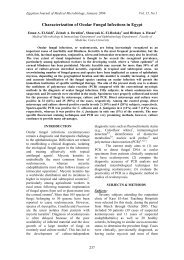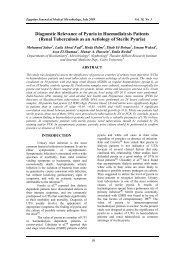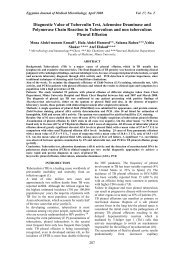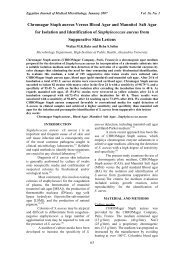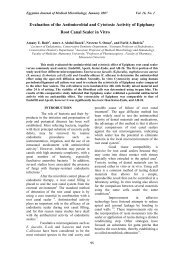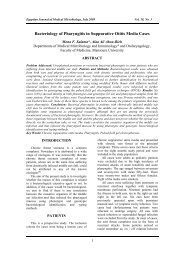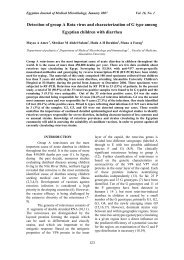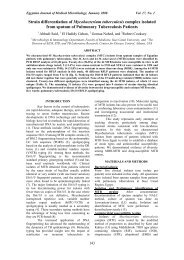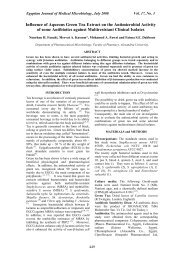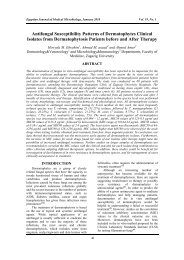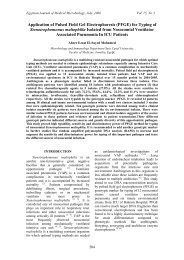Characteristics and Outcome of Patients with Influenza A (H1N1 ...
Characteristics and Outcome of Patients with Influenza A (H1N1 ...
Characteristics and Outcome of Patients with Influenza A (H1N1 ...
Create successful ePaper yourself
Turn your PDF publications into a flip-book with our unique Google optimized e-Paper software.
Egyptian Journal <strong>of</strong> Medical Microbiology, January 2010 Vol. 19, No. 1<strong>Characteristics</strong> <strong>and</strong> <strong>Outcome</strong> <strong>of</strong> <strong>Patients</strong> <strong>with</strong> <strong>Influenza</strong> A (<strong>H1N1</strong>)Infection in a Saudi Hospital1 Niveen M. Gad, 2 Zakia Abu-Zahab <strong>and</strong> 3 Zeinab Zakzouk1 Microbiology <strong>and</strong> Immunology Department, Faculty <strong>of</strong> Medicine,Benha University, Egypt. 2 Clinical Pathology <strong>and</strong> 3 Chest Departments, Faculty <strong>of</strong>Medicine for Girls, Al Azhar University, Cairo, EgyptABSTRACTNovel influenza A (<strong>H1N1</strong>) virus is the pathogen <strong>of</strong> recent global outbreaks <strong>of</strong> febrile respiratory infection.Objective: was to describe baseline characteristics, treatment, <strong>and</strong> outcomes <strong>of</strong> the majority <strong>of</strong> patients<strong>with</strong> confirmed 2009 influenza A (<strong>H1N1</strong>). Subjects <strong>and</strong> methods: Ninety seven patients diagnosed asInfleunza A (<strong>H1N1</strong>) infection by reverse transcriptase real time PCR (RT-PCR) were analyzed fordemographic data, symptoms <strong>and</strong> signs, duration <strong>of</strong> illness, dose <strong>and</strong> duration <strong>of</strong> treatment, <strong>and</strong> clinicaloutcomes. Nasopharyngeal swab or tracheal aspirate were obtained from these patients (52 males <strong>and</strong>45 females) . Results: Among 95 patients diagnosed as influenza A ( <strong>H1N1</strong>) ; 74.2% were in age groupfrom 14 to 40. All patients were positive by RT-PCR , all received antivirals <strong>and</strong> most <strong>of</strong> them recovered<strong>with</strong>out complications (95/97), <strong>with</strong> only two complicated. Conclusion: Infleunza A (<strong>H1N1</strong>) in that Saudihospital was acute respiratory illness which tended to be mild <strong>and</strong> spread rapidly. Measures is neededfor rapid diagnosis, prevent spreading <strong>and</strong> effective treatment at the appropriate time.INTRODUCTIONIn April 2009, the first two cases <strong>of</strong> humaninfection <strong>with</strong> a novel influenza A (<strong>H1N1</strong>) viruswere reported in the United States 1 . During thesame period, an outbreak <strong>of</strong> respiratoryinfection was reported in Mexico 2 . The viruswas found to be an <strong>H1N1</strong> virus that wasantigenically <strong>and</strong> genetically unrelated to humanseasonal influenza viruses <strong>and</strong> geneticallyrelated to viruses known to circulate in swine 3.Since then it spread all over the world that madethe world health organization (WHO) declaredthe first phase 6 global influenza p<strong>and</strong>emic <strong>of</strong>the century on June 11, 2009 4 .The reemergence <strong>of</strong> p<strong>and</strong>emic influenza hasbeen anticipated since the Hong Kong (H3N2)influenza p<strong>and</strong>emic <strong>of</strong> 1968. In recent years,there has been substantial concern that ap<strong>and</strong>emic would involve the novel H5N1 avianflu variant, which has demonstrated an ability tocause severe disease when transmitted tohumans 5 .There are three types <strong>of</strong> influenza viruses;A, B, <strong>and</strong> C, belonging to the Orthomyxoviridaefamily <strong>of</strong> single str<strong>and</strong>ed RNA viruses. Type A<strong>and</strong> B are associated <strong>with</strong> human infection buttype A is associated <strong>with</strong> more severe ones.Type A viruses are subtyped on the basis <strong>of</strong> twosurface glycoproteins; hemagglutinin (HA) 16subtypes <strong>and</strong> neuraminidase (NA) 9 subtypes,which can recombine to create novelcombinations <strong>of</strong> influenza, which is known asgenetic reassortment. Pigs are susceptible tohuman <strong>and</strong> avian influenza A viruses; whichmake swine serves as a melting pot to generatednew hybrid viruses 6 .When the seasonal influenza virusesundergo point mutations which modify theirgenomes, it is called antigenic shift. The typicalseasonal influenza viruses exhibit frequent pointmutations that lead to more gradual shifts intheir genomes. This process is known asantigenic drift; <strong>and</strong>, it is the reason that newinfluenza vaccines must be prepared each year.On the other h<strong>and</strong>, if there is a reassortment <strong>of</strong>the gene segments leading to the development<strong>of</strong> novel influenza A viruses, it is known asantigenic shift 6 .The novel <strong>H1N1</strong> virus has distinctmolecular properties <strong>of</strong> human, avian, <strong>and</strong>swine influenza, resulting from antigenic drift,which is the main cause <strong>of</strong> the seasonalepidemic <strong>of</strong> swine flu 3 .Live vaccine against influenza was licensedin the United States in 2003, also four antiviralmedications were approved for preventing <strong>and</strong>treating influenza. These antivirals include theM2 inhibitors, amantadine (1960’s) <strong>and</strong>rimantadine (1993), <strong>and</strong> the newerneuraminidase inhibitors, zanamivir, <strong>and</strong>oseltamivir (2000). Although the neuraminidaseinhibitors are clinically active against bothinfluenza A <strong>and</strong> B, the M2 inhibitors are activeonly against influenza A. However, the current83
Egyptian Journal <strong>of</strong> Medical Microbiology, January 2010 Vol. 19, No. 1<strong>H1N1</strong> is susceptible to neuramidinase inhibitorsbut not to M2 inhibitors 6Swine influenza virus (SIV) can betransmitted through droplet <strong>and</strong> infected fomitis.The symptoms range from fever <strong>and</strong> anorexia tocoughing, rhinorhea, <strong>and</strong> gastrointestinal upset.Pneumonia, respiratory failure, <strong>and</strong> deaths havebeen reported <strong>with</strong> swine flu infection inhumans; <strong>and</strong>, as <strong>with</strong> seasonal influenzaoutbreaks, SIV in humans can worsenunderlying chronic conditions 6 .Warning signs should be watched inpatients <strong>with</strong> confirmed <strong>H1N1</strong> or suspected tobe infected that predict progression to moresevere disease which include shortness ordifficulty <strong>of</strong> breath, turning blue, bloody orcolored sputum, chest pain, altered mentalstatus, high fever that persists after 3 days, lowblood pressure, recurrence <strong>of</strong> fever afterimprovement which may indicate secondarypneumonia. In children, danger signs includefast or difficult breathing, lack <strong>of</strong> alertness,difficulty in waking up <strong>and</strong> little or no desire toplay 7 .The aim <strong>of</strong> this work was to describebaseline characteristics, treatment, <strong>and</strong>prognosis in patients <strong>with</strong> influenza A (<strong>H1N1</strong>)admitted to a Saudi hospital <strong>and</strong> compare ourfindings <strong>with</strong> similar data published elsewhere.SUBJECTS & METHODSThis study was conducted over 4 months inthe period from September 2009 to January2010, from patients in Chest Department, PrinceAbd El Mohsen General Hospital , MadinahMonawarha .Ninety seven patients wereincluded in the study; (52) males <strong>and</strong> (45)females. Inclusion criteria consisted <strong>of</strong>: febrile(> 38°C) acute illness; respiratory symptomsconsistent <strong>with</strong> cough, sore throat, myalgia orinfluenza-like illness; acute respiratory failurerequiring intensive care unit (ICU) admission;plus microbiologic confirmation <strong>of</strong> novelinfluenza A (<strong>H1N1</strong>). <strong>Patients</strong> were admitted inisolation ward .- According to the regulation <strong>of</strong> Ministry <strong>of</strong>Health, Kingdom <strong>of</strong> Saudi Arabia; Anypatient suffered from flu symptoms morethan 3 days ; nasopharyngeal aspirates wereobtained , tested by RT-PCR for <strong>H1N1</strong> <strong>and</strong>started ostelemivir treatment <strong>and</strong> alsocontacts . The continuity <strong>of</strong> treatment or notwas according to PCR results.- From all patients <strong>with</strong> flu symptoms; only'confirmed cases' were included in thecurrent study.84- Primary viral pneumonia was defined inpatients presenting during the acute phase <strong>of</strong>influenza virus illness <strong>with</strong> acute respiratorydistress <strong>and</strong> unequivocal alveolaropacification involving two or more lobes<strong>with</strong> negative respiratory <strong>and</strong> blood bacterialcultures.- The ICU admission criteria <strong>and</strong> treatmentdecisions for all patients were made by theattending physician.- All patients were subjected for:- Medical history taking <strong>and</strong> clinicalexamination including :1. Demographic data,2. Comorbidities,- Time <strong>of</strong> illness onset <strong>and</strong> hospital admission,- Time to first dose <strong>of</strong> antiviral treatment.- Nasopharyngeal swab specimens werecollected at admission <strong>and</strong> respiratorysecretions were also obtained in intubatedpatients <strong>and</strong> put on viral transport media .These specimens were sent to King FahdReferral Hospital for RT-PCR .- Specimens were cultured on Blood,MacConkey's, <strong>and</strong> Chocolate agars toexclude concomitant bacterial disease.- Blood samples were obtained <strong>and</strong> subjectedto blood cultures on Bactec 9240 automatedblood culture system to exclude other causes<strong>of</strong> fever.- Chest radiologic findings at ICU admission.- Intubation <strong>and</strong> mechanical ventilationrequirements.- Laboratory finding at ICU admission werealso recorded to determine the severity <strong>of</strong>illness.- All patients were confirmed by RT-PCR forp<strong>and</strong>emic <strong>H1N1</strong> virus using kits from RocheDiagnostics (Germany) which included:- RNA extraction: 200 ul <strong>of</strong> binding bufferwas added to 200 ul <strong>of</strong> samplesupplemented <strong>with</strong> 4 ul poly A <strong>and</strong> 50 ul<strong>of</strong> proteinase K , mixed thoroughly <strong>and</strong>incubated for 10 min at 72 o C then mixed<strong>with</strong> 100 ul binding buffer, transferred tocombined filter <strong>and</strong> collection tubes ,centrifuged for 35 sec at 8000xg,flowthrough was discarded. 500 ul <strong>of</strong>inhibitor removal buffer was added <strong>and</strong>centrifuged again for 1 min at 8000xg<strong>with</strong> discard <strong>of</strong> the flowthrough. 450 ul <strong>of</strong>wash buffer was added <strong>and</strong> centrifugedagain 1 min at 8000xg, washed <strong>and</strong>centrifuged again, followed by centrifuge10 sec at 13000xg <strong>with</strong> discard <strong>of</strong>flowthrough. To elute viral RNA 50 ul <strong>of</strong>elution buffer was added <strong>and</strong> centrifuged
Egyptian Journal <strong>of</strong> Medical Microbiology, January 2010 Vol. 19, No. 18000xg for 1 min, then RT-PCR wasperformed on viral RNA.- RT: Using transcriptor first str<strong>and</strong> cDNAsynthesis kit , RNA is reverse transcribedinto single str<strong>and</strong>ed cDNA which can beused directly for subsequent RCR <strong>with</strong>gene specific primers on conventionalthermal block cycler <strong>and</strong> real time PCRinstrument . Master mix was prepared byadding 2ul <strong>of</strong> r<strong>and</strong>om hexamer primer,11ul <strong>of</strong> RNA template then mixture (13ul)incubated at 65 o C for 10 min then placedimmediately in ice. A mixture (7ul) <strong>of</strong> 4ul<strong>of</strong> transcriptor reverse trascriptasereaction buffer, 0.5ul <strong>of</strong> protector RNAseinhibitor, 2ul <strong>of</strong> deoxynucleotide mix,0.5ul <strong>of</strong> transcriptor reverse trascriptasewas prepared <strong>and</strong> mixed <strong>with</strong> previousmixture <strong>of</strong> 13ul to make total volume <strong>of</strong>20 ul . The reaction was centrifuged tocollect liquid in bottom, then incubated10 min at 25 o C followed by 30 min at55 o C. Transcriptor reverse trascriptasewas inactivated by heating at 85 o C for 5min. The reaction was stopped by placingin ice.- The recommended procedure for testingfor the new <strong>Influenza</strong> A/<strong>H1N1</strong> virus is thedetection <strong>of</strong> the M2 gene for <strong>Influenza</strong> A.Positive samples are then tested targetingthe specific H1 gene or parallel testing <strong>of</strong>both targets is performed. Theprimer/probe set for detection <strong>of</strong> <strong>Influenza</strong>A Hemagglutinin HA1 has beenrecommended by the Robert KochInstitute in Berlin, Germany 8. Table (1)shows primers <strong>and</strong> probes used in PCR.Table 1: Primers <strong>and</strong> probes for detection <strong>of</strong> p<strong>and</strong>emic <strong>H1N1</strong> 2009 virusAssay <strong>and</strong> Primer/probe Nucleotide Primer/probe sequence (5 –3 )gene target namelocationHAHAHAHA-359_ForHA-405_RevHA-386_Probe359–381405–424386–403AGCAATTGAGCTCAGTGTCATCATGGGCCATGAACTTGTCTTGFAM-AAAGGTTTGAGATATTCC-BHQ1bM2M2M2M-408-ForM-455_RevM-434_Probe408–432455–485434–450ACAGAAGCTGCTTTTGGTCTAGTGTTGAGACCGATGCTGTGAATCAFAM-TGCCACTTGTGAACAGA-BHQ1- RT-PCR: Master mix was prepared for20 ul capillary tube by adding ; 8.6ulPCR grade water, 2.4ul <strong>of</strong> MgCl2 , 2ul<strong>of</strong> fast start master mix <strong>and</strong> 2ulprimer/probe mix. 5ul <strong>of</strong> viral RNAsample, positive or negative controlwere dispensed in separate tube <strong>with</strong> thesame reaction mixture. Mixture weretransferred to the respective <strong>of</strong> LightCycler ®Capillaries, which werespinned in a microcentrifuge at 700×g(3,000rpm) for 10 sec , <strong>and</strong> placed intothe Light Cycler ® 2.0 system to startthe PCR program.RESULTSThe current study was conducted on 97patients whom were admitted to hospital due to<strong>H1N1</strong> infection .Their age ranged between 12<strong>and</strong> 75 (mean 34± SD 16.99). Seventy twopatients (74.2%) ranged between 14 <strong>and</strong> 40years old (mean 25.29 ± 7.98), <strong>and</strong> 16 patients(16.5%) were less than 52 years old (mean 45 ±4.08). Nine patients (9.3%) were older than 65years old (mean 69 ±3.4). Fifty two patients(53.6%) were males, forty five patients (46.4%)were females, 4 <strong>of</strong> them were pregnant.All patients included were admitted tohospitals due to flu symptoms more than 3 days,flu symptoms <strong>with</strong> underlying chronic diseaseor presenting pneumonia. Figure (1) showspercentage <strong>of</strong> different symptoms in studiedgroup.The most common comorbidities weresmoking (18 patients), lung diseases; mainlybronchial asthma (BA) (11 patients) <strong>and</strong>exacerbated chronic obstructive lung disease(COPD) (7 patients). Only one patient hadsevere obesity (body mass index > 40). Table(2) shows the comorbidities in the studiedgroup.The average duration <strong>of</strong> hospital stay wasbetween 5 <strong>and</strong> 7 days.All patients received initial empiricantibiotic therapy. Most frequent regimens werebeta lactam plus macrolides, In addition twoICU admitted patients received intravenoussteroids.All patients were administered oseltamivir,3 <strong>of</strong> them were administered higher doseoseltamivir up to 150 mg oral twice a day.85
Egyptian Journal <strong>of</strong> Medical Microbiology, January 2010 Vol. 19, No. 1Fig. 1: Percentage <strong>of</strong> signs <strong>and</strong> symptoms <strong>of</strong> Infleunza <strong>H1N1</strong> in confirmed cases.Table 2: Most common comorbidities <strong>of</strong>patients <strong>with</strong> p<strong>and</strong>emic Infleunza <strong>H1N1</strong>ComorbiditiesNo. <strong>of</strong>cases%Number <strong>of</strong> comorbidities :- Non- 1 comorbidity- >1 comorbidity66201168%20.611.4Type <strong>of</strong> comorbidity:Smoking 18 18.6%Lung diseases:- BA 112- COPD 27- ARDS 32- Pickwickian syndrome 4 112.4%7.22.11.03Obesity 1 1.03Hypertension 3 3.1Pregnancy 4 4.1Hear diseases :- SVT 5- IHD 6- Rheumatic heart1111.031.031.03Diabetes Mellitus 4 4.1Renal transplant 1 1.03Herpes simplex 1 1.03Allergic Rhinitis 1 1.03Hypothyrodism 2 2.1Cancer 2 2.1Congenital : Down syndrome 1 1.031 Bronchial asthma; 2 Chronic obstructive lungdisease; 3 Acute respiratory distress syndrome4 hypoventilation syndrome;5 supraventriculartachycardia; 6 Ischemic heart diseaseOnly confirmed patients <strong>of</strong> <strong>H1N1</strong> infectionby RT –PCR were included in this study. PCRwas negative in two patients at ICU admission;they were later confirmed to have the infectionthrough further determination <strong>of</strong> trachealsecretions.All patients in the study were recoveredtotally except 2 who required mechanicalventilation due to viral primary pneumonia<strong>with</strong> chest radiograph <strong>of</strong> bilateral patchyalveolar opacities (predominantly basal) thatprogressed rapidly to affect all lung fields(Acute Respiratory Distress Syndrome) (ARDS)finding.The first patient was female patient, 60years old <strong>with</strong> COPD, whom complaint startedabout 10 days before admission, this patientdied <strong>with</strong>in 12 hrs. Another 30 years pregnantfemale <strong>with</strong> BA, who died after 1 month due tomultiorgan failure. Chest computed tomographyscan was performed on this patient <strong>and</strong> showedairspace consolidation <strong>and</strong> ground glass opacityin the multilobar <strong>and</strong> bilateral distribution. Shealso had elevated direct <strong>and</strong> indirect bilirubin,high creatinine level <strong>and</strong> high liver enzymes(ALT <strong>and</strong> AST). For this patient, abdominalultra-sonograghy revealed only congested liver<strong>with</strong> normal diameter <strong>of</strong> common bile duct.An amazing two old women patient, 75years old, <strong>with</strong> COPD, <strong>and</strong> ischemic heartdisease (IHD) <strong>and</strong> who had gastrectomy due toprevious cancer stomach. Another woman 72years <strong>with</strong> concurrent laryngeal carcinoma.Both recovered <strong>with</strong>out complications.86
Egyptian Journal <strong>of</strong> Medical Microbiology, January 2010 Vol. 19, No. 1No patient was complicated <strong>with</strong> secondarybacterial pneumonia or associated <strong>with</strong>bacteriamia .7 cases <strong>of</strong> influenza <strong>H1N1</strong> were reported innurses due to contact <strong>with</strong> patientsDISCUSSIONSince 2000, the WHO has promptedcountries to prepare for a potential influenzap<strong>and</strong>emic. Activities included the introduction<strong>of</strong> yearly influenza vaccination <strong>and</strong> a strategicreserve <strong>of</strong> oseltamivir, antibiotics, <strong>and</strong>protective items for health care personnel wasestablished in 2006 9 . Since the emergence <strong>of</strong> thenovel <strong>H1N1</strong> influenza 2009 in mid April, thenumber <strong>of</strong> confirmed cases has increased tomillions across the world <strong>with</strong> at least 17000deaths till writing this study 10 .Table 3: <strong>Characteristics</strong> <strong>of</strong> 97 patientsconfirmed <strong>of</strong> <strong>H1N1</strong> infleunza virus.VariablesValueAge years (mean ± SD) 34.5± 16.99Male (No. , %) 52 (53.6%)Female (No. , %) 45 (46.4%)Leucopenia (No. , % ) ( 88 , 91% )Less than 3000/mm 3Median number <strong>of</strong> days (1.5 days ± 0.6)from illness onset toinitiation <strong>of</strong> antiviral ttt(mean ± SD)No. <strong>of</strong> patients receiving 97 (100%)antiviral ttt before testingresults available.Duration <strong>of</strong> oseltamivir tttClinical outcome: (No.,%)CuredDiedTransferredMechanical ventilation(No. , % )- No- YesRange ( 5-10 days)(6 ± 1.8)95 (97.9 %)1 (1.03% )1 (1.03% )95 (97 .9%)2 (2.1%)Most <strong>of</strong> our patients were young to middleaged<strong>and</strong> had previously been healthy. Themajority <strong>of</strong> infections reported have been mild,influenza-like illnesses. This has been reportedin other countries 11,12 .Fever, fatigue <strong>and</strong> respiratory symptomswere harbingers <strong>of</strong> disease in almost all cases inthis study <strong>and</strong> in others 12,13, 14 .The most common comorbidities amongpatients in this study were lung diseases <strong>and</strong> ahistory <strong>of</strong> smoking. This agreed <strong>with</strong> otherstudies 9,12,13 . Also Kumar et al. 12 reported thatamong critically ill patients, obesity has beenshown to be a risk factor for increasedmorbidity, but not consistently <strong>with</strong> mortality.The association <strong>of</strong> obesity <strong>with</strong> severe 2009influenza A (<strong>H1N1</strong>) infection has been reportedby others 13,14,15 , <strong>and</strong> may be a novel finding <strong>of</strong>this p<strong>and</strong>emic.This study has point <strong>of</strong> strength. It includesboth adults <strong>and</strong> children from geographically<strong>and</strong> racially diverse settings across MadinahMonawarha region, which improves thegeneralizability <strong>of</strong> our results to other regions.The tendency <strong>of</strong> females to develop severe2009 influenza A (<strong>H1N1</strong>) infection in this seriesis striking. A general female susceptibility hasnot been observed in other influenza case series<strong>of</strong> variable severity including the initial reports<strong>of</strong> 2009 influenza A (<strong>H1N1</strong>) infections 3 . Inmost infectious diseases <strong>and</strong> related conditionssuch as sepsis <strong>and</strong> septic shock, males representa larger proportion <strong>of</strong> cases <strong>and</strong> have a highermortality 16 . The explanation for increased risk<strong>of</strong> severe disease <strong>and</strong> death among females isunclear but the role <strong>of</strong> pregnancy as a risk factorhas been noted in previous influenzap<strong>and</strong>emics 17 . In spite <strong>of</strong> that the 4 pregnantcases in this study recovered completely <strong>with</strong>outcomplications, maybe due to the earlyintroduction <strong>of</strong> antiviral as recommended byWHO 18 .Padilla et al. 9 reported that false negativetest in patients would be more likely if the testwere delayed (as the 2 cases in this study), or ifpatients had limited viral shedding. Theynoticed that patients who tested negative for<strong>H1N1</strong> had a milder clinical course than thosewho tested positive but were as much a part <strong>of</strong>the burden <strong>of</strong> the epidemic as those who werenot tested.Unusual features <strong>of</strong> severe disease in thecurrent p<strong>and</strong>emic compared <strong>with</strong> most previouswell characterized p<strong>and</strong>emics, including the(probable) H2N2 1890 Russian influenzap<strong>and</strong>emic, the H2N2 1957 Asian influenzap<strong>and</strong>emic, <strong>and</strong> the H3N2 1968 Hong Kongp<strong>and</strong>emic. In these previous influenzap<strong>and</strong>emics, an increased predilection forinfection among children <strong>and</strong> young adults hasbeen documented 19 although mortality curveswere U shaped <strong>with</strong> increased deaths in the veryyoung <strong>and</strong> the aged. Data suggested 12,13 thatsevere disease <strong>and</strong> mortality in the currentoutbreak is concentrated in relatively healthyadolescents <strong>and</strong> adults between the ages <strong>of</strong> 10<strong>and</strong> 60 years, a pattern reminiscent <strong>of</strong> the W-87
Egyptian Journal <strong>of</strong> Medical Microbiology, January 2010 Vol. 19, No. 1shaped curve previously seen only during the1918 <strong>H1N1</strong> Spanish p<strong>and</strong>emic 20 . Few patientsolder than 60 years were admitted to the ICU. Apotential biological basis for this observation isthat patients in this age group have a crossreactiveantibody to 2009 influenza A (<strong>H1N1</strong>) atmuch higher rates than younger patients 21 .(<strong>H1N1</strong>) 2009 influenza A recorded casefatalityrate <strong>of</strong> approximately 1% yet this maywell be an overestimate, because testing is nolonger being reported in many regions <strong>and</strong> evenmany cases expected as mild flu <strong>with</strong>outtesting 22 . The case-fatality rate in previousinfluenza p<strong>and</strong>emics has varied widely, <strong>and</strong> allsuch reports may be inaccurate owing todifficulty in assessing the total number <strong>of</strong>cases 23 . The Spanish flu <strong>of</strong> 1918 (<strong>H1N1</strong> ) wasreported as causing 50 million deaths in 500million individuals infected (10% case-fatalityrate), while the Hong Kong flu <strong>of</strong> 1968-1969caused 33000 deaths among 50 million infected(0.1% case fatality rate) 24 . The case-fatality rate<strong>of</strong> avian influenza A (H5N1) was initiallyreported to be as high as 60% but is more likelyin the range <strong>of</strong> 14% to 33% 25 .During the 1918 p<strong>and</strong>emic, a large number<strong>of</strong> deaths were associated <strong>with</strong> bacterialinfection 26 , but concurrent bacterial infectiondoes not appear to be a major contributingfactor to the severity <strong>of</strong> illness in our patients,possibly in part because most receivedantibiotics before hospitalization. This goes inh<strong>and</strong> <strong>with</strong> 9 . Lung damage was most likely dueto the primary effect <strong>of</strong> infection <strong>with</strong> influenzavirus. Possible mechanisms <strong>of</strong> damage includedirect injury to the respiratory epithelium <strong>with</strong> asecondary cytokine storm 27 . They alsowondered whether patients, especially thosewho died, had viremia, as was reported inassociation <strong>with</strong> H5N1 infection, a veryaggressive variety <strong>of</strong> influenza 28,29 . Coinfection<strong>with</strong> other respiratory viruses could also explainthe increased pathogenicity among patients 30 .Oseltamivir (Tamiflu) <strong>and</strong> zanamivir(Relenza) reduce viral replication <strong>and</strong> shedding,<strong>and</strong> may reduce the risk <strong>of</strong> more severe illness.Their safety in pregnancy has not beeninvestigated, but <strong>with</strong>out treatment there may bea greater risk <strong>of</strong> death <strong>and</strong> premature labour 31,32 .Increasing resistance to oseltamivir has beenreported in other strains <strong>of</strong> currently circulatinginfluenza A viruses <strong>and</strong> in <strong>H1N1</strong>, but, as yet,<strong>H1N1</strong> influenza 2009 lineage was not able to betransmitted between patients <strong>and</strong> almost allcases who developed resistance where inpatients <strong>with</strong> severe underlying diseases 33 .88WHO new guidelines for use <strong>of</strong> antiviralsin management <strong>of</strong> cases recommends thathealthy patients <strong>with</strong> uncomplicated illness neednot to be treated <strong>with</strong> antiviral world wide, mostpatients fully recovered <strong>with</strong>out any form <strong>of</strong>medical treatment. Oseltamivir should beadministered to children below 5 years <strong>of</strong> old,pregnant women <strong>and</strong> patients <strong>with</strong> underlyingconditions 18 .In conclusion, most cases <strong>of</strong> <strong>H1N1</strong>infection were mild <strong>and</strong> responded well toantiviral treatment <strong>and</strong> only minor casesprogressed to cause serious illness <strong>and</strong> death.Future studies should identify predictive factorsfor severe disease <strong>and</strong>, especially, theeffectiveness <strong>of</strong> early treatment <strong>and</strong> protection<strong>of</strong>fered by having influenza vaccination.Immediate strategies for containment havebecome the key factor in preventing the spread<strong>of</strong> this virus. Drastic <strong>and</strong> intense precautionarymeasures are needed to make <strong>H1N1</strong> containable<strong>and</strong> preventable. The role <strong>of</strong> academies,researchers, educators, media, industry, <strong>and</strong>international agencies is crucial to ensure thatpeople get the right information at the right timeso that the outcome can be positive in this time<strong>of</strong> global fear <strong>and</strong> infectious crisis.REFERENCES1. Centers for Disease Control <strong>and</strong>Prevention (CDC) 2009. Swine influenzaA (<strong>H1N1</strong>) infection in two children-Southern California, March-April. MMWRMorb. Mortal Wkly Rep., 58(15): 400-402.2. Centers for Disease Control <strong>and</strong>Prevention (CDC) 2009. Outbreak <strong>of</strong>swine-origin influenza A (<strong>H1N1</strong>) virusinfection- Mexico, March-April 2009.MMWR Morb Mortal Wkly Rep., 58(17):467-470.3. Dawood, F.S., Jain, S. <strong>and</strong> Finelli, L.2009. Novel Swine-Origin influenza(<strong>H1N1</strong>) Virus Investigation Team.Emergence <strong>of</strong> a novel swine origininfluenza A (<strong>H1N1</strong>) virus in humans. N.Engl. J. Med., 360(25): 2605-2615.4. Chan, M. 2009. World now at the start <strong>of</strong>2009 influenza p<strong>and</strong>emic. http://www.who.int/mediacentre/news/statements/2009/h1n1_p<strong>and</strong>emic_phase6_20090611/en/index.html.5. Clem, A. <strong>and</strong> Galwankar, S. 2006. Avianinfluenza: Preparing for a p<strong>and</strong>emic. J.Assoc. Physicians India, 54: 563-70.6. Galwantar, S. <strong>and</strong> Clem, A., 2009. Swineinfluenza A (<strong>H1N1</strong>) strikes a potential for
Egyptian Journal <strong>of</strong> Medical Microbiology, January 2010 Vol. 19, No. 1global disaster; Journal <strong>of</strong> Emergencies,Trauma, <strong>and</strong> Shock, 2: 99-1057. Shun Shin, M., Thompson, M. <strong>and</strong>Heneghan, C.B.M.J. 2009. Neuramidinaseinhibitors for treatment <strong>and</strong> prophylaxis <strong>of</strong>Infleunza in children: systemic review <strong>and</strong>metaanalysis <strong>of</strong> r<strong>and</strong>omized controlledcontrolled trials. JAMA. 302(17):1872-1879.8. Furuse, Y., Suzuki, A., Kamigaki, T. <strong>and</strong>Oshitani, H. 2009. Evolution <strong>of</strong> the Mgene <strong>of</strong> the influenza A virus in differenthost species: large-scale sequence analysis.Virology Journal, 6: 67.9. Padilla, R.P.; Zamboni, D.D.L.; De Leon,S.P.; Hern<strong>and</strong>ez, M., Falconi, F.Q.,Bautista, E., Venegas, A.R., Serrano,J.R., Ormsby, C.E., Corrales, A.,Higuera, A., Mondragon, E. <strong>and</strong>Villalobos, J.A.C. 2009. Pneumonia <strong>and</strong>Respiratory Failure from Swine-Origin<strong>Influenza</strong> A (<strong>H1N1</strong>) in Mexico. N. Engl. J.Med. 361, 7.10. World Health Organization 2010. GlobalAlert <strong>and</strong> Response (GAR). <strong>Influenza</strong>A(<strong>H1N1</strong>)- update 93. Laboratoryconfirmedcases <strong>of</strong> new influenza A(<strong>H1N1</strong>)as <strong>of</strong>ficially reported to WHO by StatesParties to the International HealthRegulations (2005).http://www.who.int/csr/don/11. Update, 2009. Infections <strong>with</strong> a swineorigininfluenza A (<strong>H1N1</strong>) virus - UnitedStates <strong>and</strong> other countries, April 28, 2009.MMWR Morb Mortal Wkly Rep. 58: 431-3.12. Kumar, A.; Zarychanski, R. <strong>and</strong> Pinto,R. 2009. Infection in Canada Critically Ill<strong>Patients</strong> With <strong>Influenza</strong> A(<strong>H1N1</strong>). JAMA.302(17):1872-1879.13. Cherit, G.M.; Lapinsky, S.E. <strong>and</strong>Macias, A.E. 2009. Critically Ill <strong>Patients</strong><strong>with</strong> 2009 <strong>Influenza</strong> A (<strong>H1N1</strong>) in MexicoJAMA. 302(17): 1880-1887(doi: 10.1001/JAMA. 1496).14. Napolitano, L.M., Park, P.J. <strong>and</strong> Sihler,K.C. 2009. Intensive care patients <strong>with</strong>severe novel influenza A (<strong>H1N1</strong>) virusinfection-Michigan, June 2009. MMWRMorb Mortal Wkly Rep. 58: 1- 4.15. World Health Organization (WHO)2009: Infobase: BMI/ overweight/ obesity.https:// apps.who.int/infobase/.16. Kumar, A., Roberts, D. <strong>and</strong> Wood, K.E.,2006. Duration <strong>of</strong> hypotension beforeinitiation <strong>of</strong> effective antimicrobial therapyis the critical determinant <strong>of</strong> survival inhuman septic shock. Crit. Care Med., 34(6):1589-1596.17. Beigi R.H., 2007. P<strong>and</strong>emic influenza <strong>and</strong>pregnancy: a call for preparednessplanning. Obstet Gynecol., 109(5): 1193-1196.18. Burch, J. <strong>and</strong> Stock, C. 2009. Prescription<strong>of</strong> anti influenza drugs for healthy adults: asystemic review <strong>and</strong> meta analysis. LancetInfect Dis. 3099(09): 70199-9.19. Cunha, B.A. 2004. <strong>Influenza</strong>: historicalaspects <strong>of</strong> epidemics <strong>and</strong> p<strong>and</strong>emics. Infect.Dis. Clin. North Am., 18(1): 141-155.20. Oxford, J.S. 2000. <strong>Influenza</strong> A p<strong>and</strong>emics<strong>of</strong> the 20th century <strong>with</strong> special reference to1918: virology, pathology <strong>and</strong>epidemiology. Rev. Med. Virol., 10(2):119-133.21. Centers for Disease Control <strong>and</strong>Prevention (CDC) 2009. Serum crossreactiveantibody response to a novelinfluenzaA (<strong>H1N1</strong>) virus after vaccination<strong>with</strong> seasonal influenza vaccine. MMWRMorb Mortal Wkly Rep., 58(19): 521-524.22. Global Alert <strong>and</strong> Response (GAR) 2009.P<strong>and</strong>emic (<strong>H1N1</strong>): World HealthOrganization Web site.http://www.who.int/csr/disease/swineflu/en.23. Fraser, C.; Donnelly, C.A. <strong>and</strong>Cauchemez, W. 2009. WHO RapidP<strong>and</strong>emic Assessment Collaboration.P<strong>and</strong>emic potential <strong>of</strong> a strain <strong>of</strong> influenzaA (<strong>H1N1</strong>): early findings. Science,324(5934): 1557-1561.24. Kerr, J.R., 2009. Swine influenza. J. Clin.Pathol. 62(7): 577 - 578.25. Li, F.C.; Choi, B.C., Sly, T. <strong>and</strong> Pak,A.W. 2008. Finding the real case-fatalityrate <strong>of</strong> H5N1 avian influenza. J. Epidemiol.Community Health., 62(6): 555-559.26. Morens, D.M., Taubenberger, J.K. <strong>and</strong>Fauci, A.S. 2008. Predominant role <strong>of</strong>bacterial pneumonia as a cause <strong>of</strong> death inp<strong>and</strong>emic influenza: implications forp<strong>and</strong>emic influenza preparedness. J. Infect.Dis., 198: 962-70.27. Ng, W.F., To, K.F., Lam, W.W., Ng, T.K.<strong>and</strong> Lee, K.C. 2006. The comparativepathology <strong>of</strong> severe acute respiratorysyndrome <strong>and</strong> avian influenza A subtypeH5N1- a review. Hum. Pathol., 37: 381-90.28. Hui DS. 2008. Review <strong>of</strong> clinicalsymptoms <strong>and</strong> spectrum in humans <strong>with</strong>influenza A/H5N1 infection. Respirology13: Suppl. 1: S10-S13.89
Egyptian Journal <strong>of</strong> Medical Microbiology, January 2010 Vol. 19, No. 129. Yu, H.; Gao, Z. <strong>and</strong> Feng, Z., 2008.Clinical characteristics <strong>of</strong> 26 human cases<strong>of</strong> highly pathogenic avian influenza A(H5N1) virus infection in China. PLoS One3(8): e2985.30. Merler, S.; Poletti, P.; Ajelli, M.; Caprile,B. <strong>and</strong> Manfredi, P. 2008. Coinfection cantrigger multiple p<strong>and</strong>emic waves. J. Theor.Biol., 254: 499-507.31. Cheng, A.C., Dwyer, D.E., Kotsimbos,A.T.C. 2009. ASID/TSANZ guidelines:treatment <strong>and</strong> prevention <strong>of</strong> <strong>H1N1</strong>influenza 09 (human swine influenza) <strong>with</strong>antiviral agents. Med. J. Aust. 18 Jun.32. Centers for Disease Control <strong>and</strong>Prevention (CDC) 2009. Novel influenzaA (<strong>H1N1</strong>) virus infections in three pregnantwomen-United States, April–May 2009.MMWR Morb Mortal Wkly Rep., 58: 497-500.33. World Health Organization (WHO)2010. <strong>H1N1</strong> 2010 report resistance tooseltamivir- .Rapid development <strong>of</strong> drugresistance 2009 <strong>H1N1</strong> Infleunza reported in2 cases -http://www.who. int/csr/disease/influenza/<strong>H1N1</strong>.90
Egyptian Journal <strong>of</strong> Medical Microbiology, January 2010 Vol. 19, No. 1،،الخصائص و الآثار الناجمة في المرضى المصابين بفيروس اتش ١ ان ١في مستشفى سعودي٣٢١د.نيفين جاد د. زآية أبو الذهب و د. زينب زقزوققسم الميكروبيولوجي و المناعة آلية الطب ، جامعة بنها قسم الباثولوجيا الاآلينيكية و قسم الصدريةطب بنات ، جامعة الأزهر،٣٢،١آلية،،:.مقدمة:فيروس انفلونزا اتش ١ ان ١ هو المسبب لعدوى الجهاز التنفسي المصاحبة بارتفاع درجة الحرارة الذي انتشر بصورةوبائية أخيراالهدف من هذه الدراسة:هو وصف الخصائص الرئيسية للمرض العلاج و الاثار الناجمة عن المرض في المرضى المؤآد اصابتهم بفيروس اتش١ ان . ٢٠٠٩ ١الحالات و طريقة العملتم أخذ مسحة من الأنف أو القصبة الهوائية من المرضى الذين لديهم أعراض انفلونزا من بينهم تم انتقاء فقط المرضى الذينتم التأآد من اصابتهم بفيروس اتش ١ ان ١ بطريقة ال بي سي ارتم دراستهم من حيث الأعراض مدة المرض ، جرعة و مدة العلاج و نتيجة المرض،،.،.(٩٧ مريض ) ٥٢ رجل و ٤٥ أنثى (.النتائج:-)---آل الحالات المشمولة بالبحث آانت مؤآدة اصابتهم بفيروس اتش ١ ان ١ بطريقة ال بي سي ار.من الحالات آانوا في المرحلة العمرية من ١٤-٤٠ سنة.آل المرضى تم علاجهم بمضادات الفيروساتمعظم المرضى ماعدا حالتين تعافوا بدون أي مضاعفاتالاستنتاجفيروس اتش ١ ان ١ يسبب عدوى معتدلة الشدة غالبا في الجهاز التنفسي و لكن ينتشر بسرعة. الاحتياطات واجبة لسرعةالتشخيص و العلاج ومنع انتشار المرض في الوقت المناسب..%٧٤٫٢:91



